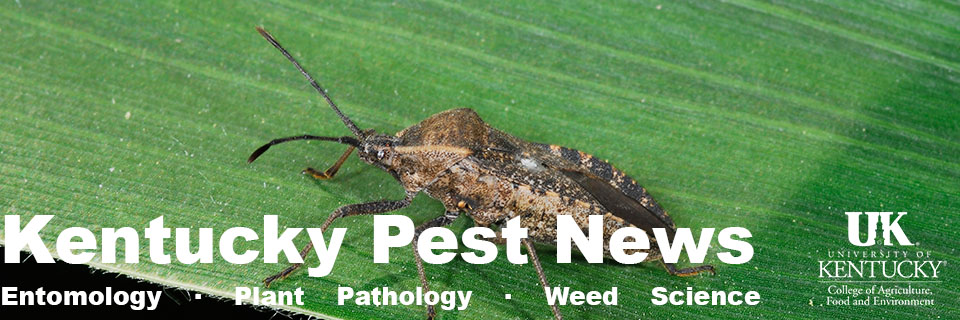Many apple and pear trees are in bloom throughout Kentucky. Infection by the fire blight bacterium occurs during bloom, thus, protectant antibiotics should be applied when risk is high. Risk for infection can be assessed using the Fire Blight Disease…
Monthly Archives: April 2018
Mating Disruption for Codling Moth in Orchards
This spring, the Kentucky Horticultural Society worked with Pacific Biocontrol Corporation to register a mating disruption product for Kentucky. With this arrangement, Pacific Biocontrol submitted the application to the Kentucky Department of Agriculture and the Kentucky Horticultural Society paid the…
A Great Spring for Aphids
This long spring is ideal for aphids. Colonies of the small sap-feeders (Figure 1) can be found on many landscape plants now. Impacts of aphids vary widely. Some species manage to remove sap without any obvious effect on plants. However,…
Black Flies
There has been a significant outbreak of black flies in the Arkansas delta this spring (see this article). In Kentucky, these biting gnats were attacking people last week in Jefferson County. Historically, black flies have tormented livestock along streams and…
Fire Blight (PPFS-FR-T-12)
Fire blight is a highly destructive disease of apple and pear that can occur in commercial orchards and residential plantings. Many landscape trees and shrubs in the rose family are also susceptible to this disease. Under favorable environmental conditions, fire…
2018 Insect Trap Counts
Trap counts for major insect pests are provided by the Kentucky IPM Program. Traps are located at the UK Research and Education Center in western Kentucky and the UK Spindletop Farm in Lexington. Below are trap counts for the current…
Dogwood Anthracnose Spotted
Anthracnose of dogwood is a common problem in Kentucky. Symptoms on landscape and forest dogwoods often first appear during wet periods in late spring. If left unmanaged, the pathogen spreads, eventually resulting in plant death. Selection of resistant varieties and…
Watch for Seedling Blights in Corn
The abnormally cool, wet spring has delayed planting across Kentucky. Although farmers are understandably eager to begin planting corn, planting into cool, wet soils can increase the risk of seedling blight. Causes Seedling blights are caused by several soil- or…
Be on the Lookout for Stripe Rust of Wheat
Stripe rust (Figure 1) was observed at a very low incidence in wheat research plots at the University of Kentucky Research and Education Center in Princeton (Caldwell County) late last week. Also last week, stripe rust was detected in Gallatin…
Blackleg of Potato
Potatoes are often one of the first crops planted into the vegetable garden. However, growers and gardeners alike should be on the lookout for blackleg disease. This disease can occur in both commercial and homegrown potatoes. “Seed” potatoes may be…
Fire Blight Alert and Risk Map Overview
Many apple and pear trees are in bloom throughout Kentucky. Infection by the fire blight bacterium occurs during bloom, thus, protectant antibiotics should be applied when risk is high. Risk for infection can be assessed using the Fire Blight Disease…
Pesticides and Responsible Pollinator Protection
Pollinator protection has become a common phrase we frequently hear. Those of us working in agriculture recognize that honey bees and other pollinators are as much a part of agriculture as cattle and corn. Losses of honey bees since 2006…
Backyard Apple Disease and Pest Management Using Cultural Practices (PPFS-FR-T-21)
Backyard apple production requires a proactive approach to disease, insect, and weed management. Preventative management practices can help minimize pesticide use in home orchard settings. This publication presents recommended cultural practices, along with chemical management strategies, for each apple growth…
2018 Insect Trap Counts
Trap counts for major insect pests are provided by the Kentucky IPM Program. Traps are located at the UK Research and Education Center in western Kentucky and the UK Spindletop Farm in Lexington. Below are trap counts for the current…
Fire Blight Alert and Risk Map Overview
Apple trees are approaching bloom and many pear are in full bloom, especially in southwestern Kentucky. Infection by the fire blight bacterium occurs during bloom, thus, protectant antibiotics should be applied when risk is high. Risk for infection can be…
